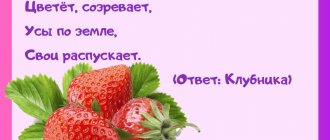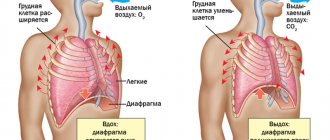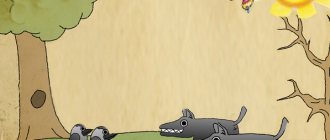LiveInternetLiveInternet
Saturday, September 07, 2022 14:43 + to quote book
The purpose of exercises for the development of auditory attention is to teach the child to listen and hear. Game “Speaking in a Whisper” Place toys on the table: cubes, a doll, a bunny, a car, and so on. Place your child at the table and explain to him that you will give him tasks very quietly - in a whisper, so he needs to listen to you very carefully in order to hear everything. Move 2 - 3 meters away from the child and start giving tasks: “Take the bunny. Put him in the car. Place one cube on top of another.” Give short, simple tasks, speak quietly but clearly so that the baby hears, understands and completes the tasks. If several children are participating in the game, you can give them joint tasks, for example: “Hold hands”, “Jump”, “Walk around the chair”, “Raise your hand up”, “Point to your nose”. Game “Listening to Words” You pronounce a variety of words, and the child needs to clap his hands when he comes across a word that means, for example, dishes. And the game begins: various words are called: chair, tree, plate, pen, fox, potato, fork. The child must have time to clap his hands in time. So that the game does not get boring, you can diversify it. After playing for a few minutes, you can change tasks. The child will need to perform other actions, for example: stomp when he hears the word for plant; jump when he hears a word for an animal; hold your nose when you hear the word for furniture. When the baby begins to cope, the tasks can be complicated by combining them in twos, and then in threes. For example, a child should clap his hands when he hears words denoting a plant, and jump when pronouncing words denoting an animal. Game “Guess whose sound” For the game you will need musical toys and various objects, for example: a pipe, wooden spoons, a tambourine, paper. To begin with, three items will be enough, and gradually they can be increased. Discuss with your child that different objects make different sounds. Show him how the paper rustles, how the spoons knock, how the pipe sounds, how the tambourine knocks. Invite him to play a game where he guesses what it sounds like. Then sit with your backs to each other and start making different noises and sounds with different objects. The baby must, without turning around, name what produced the sound. Game "Top Clap" You pronounce different phrases, both correct and incorrect. If the expression is correct, the child should clap his hands; if it is not correct, the child should stomp. And the game begins. The younger the child, the simpler the phrases and concepts should be. For example, for a three-year-old child, you can say the following phrases: “Tomatoes are always blue,” “We eat soup with a spoon,” “They eat potatoes raw,” “People walk on their hands.” For a five-year-old child, you can already complicate the concepts: “The bear lives in the village,” “Squirrels love nuts,” “Crocodiles live in the forest.” Phrases must be selected according to the child’s intellectual development, so that it is both not difficult for him to guess the correct phrases and not boring. Game “On the table! Under the table! Knock!" Invite your child to play a game in which he will follow your commands correctly. You will give verbal commands, and at the same time try to confuse the child. To do this, first say the command and follow it correctly yourself, the baby will repeat everything after you. Then you begin to confuse the child - say one command, but do something else. For example, you say: “Under the table!” and you hide your hands under the table, the child hides his hands, repeating everything after you. "Knock!" and start banging on the table, the child repeats. “On the table!” – put your hands on the table, the child does the same, and so on. When the child gets used to repeating the movements after you, begin to confuse him: say one command and perform another movement. For example, say: “Under the table!”, and then knock on the table. The child should do what you say, not what you do. Game “Nose - Floor - Ceiling” Agree with the children that when you say the word “nose”, the children need to point their finger at their nose. When you say the word "ceiling", children should point their finger at the ceiling, and when they hear the word "floor", they should point their finger at the floor. Children need to be explained that they cannot succumb to provocation: they must follow the commands that you pronounce, and not those that you show. Then start saying the words: “nose”, “floor”, “ceiling” in different sequences, and show either correctly or incorrectly. For example, call your nose and point to the floor. Children should always point in the right direction. Game “Find a Pair” To play the game you will need several identical pairs of different objects. You can mix different pairs of socks, you can cut out pairs of strips of different lengths from paper, you can choose pairs of different buttons. Place the selected pairs of objects mixed in one pile in front of the child and give him the task of choosing the pairs. If it's socks, your baby will need to choose pairs of socks. If these are strips, then he will need to select pairs of strips of the same length. If these are buttons, the child selects pairs of identical buttons. For three-year-old children, 3 to 5 pairs of different objects will be enough. The older and more experienced a child becomes in the game, the more pairs of different objects can be given to him. If several children are participating in the game, then you can give each child their own set of different pairs. You can also divide the children into teams and arrange a competition to see which team will select pairs faster. Game “Harvesting” For the game you will need silhouettes of different fruits and vegetables cut out of multi-colored cardboard - orange carrots, red tomatoes, green cucumbers, blue eggplants, yellow apples. Scatter colorful cardboard figures on the floor and ask your child to collect one vegetable or fruit. If there are several children, then each is given his own task. In this case, the number of “varieties” of cut vegetables and fruits should be equal to the number of children. And the number of different figures should be the same. If there are many children, then divide them into teams. Let them compete to see whose team can harvest their crops the fastest. To make harvesting more interesting for children, they can be given baskets. Note: games in this series help develop concentration, selectivity and distribution of attention. These games are good for children's party scenarios. Game “Catch - Don’t Catch” To play you will need a ball. The game can be played with one child or with a group of children. Agree with your child that you will throw the ball to him, and he will catch or return it. If you say a word, for example: “Catch!”, the child needs to catch the ball. If the ball is thrown silently, then it must be returned. Start the game by alternating the word “Catch” and silence during the throw. When the child gets used to the rhythm, start knocking it down, then say “Catch” several times in a row, then remain silent during throws. Gradually make the game more difficult by adding the word “Don’t catch!” The child must still catch the ball, because according to the terms of the game, he can only hit the ball during silence. Game “Do It Right” To play you will need a tambourine and handkerchiefs. The number of handkerchiefs must be equal to the number of children participating in the game. Give the children handkerchiefs and explain that when you ring the tambourine loudly, they should raise their handkerchiefs and wave them, and if you ring quietly, have the children lower their handkerchiefs. Demonstrate what it means to ring loudly and how to ring quietly. During the game, alternate loud and quiet sounds no more than three to four times. Game “Listen and do as I do” Clap your hands to a certain rhythm and invite your child to repeat after you. Tap the rhythm with a stick on the table, on a drum, on a pan, on a book or on a jar. Let the child reproduce your rhythm exactly. Then change roles - the baby taps the rhythm, and you repeat. The older the child, the more complex the rhythm can be. For a three-year-old child, the rhythm should contain no more than 5 to 6 beats. As you master the game, the rhythms can gradually become more complex. Game “Can he walk or not” Agree with your baby that you will name different words, and he needs to listen carefully. If he hears the name of an animal or object that can walk, the child should slap his knees. If he hears the name of an object that does not walk, he needs to raise his hands in front of him. Start the game: “Ball, cucumber, fox, parrot...” - you say and make sure that the child reacts correctly to each word. This game can be played with a group of children. The tasks of the game can be changed periodically: “flying or not” - children raise their hands when they hear the name of a flying object, and clap their hands when a non-flying object is named. “Round or not”, “fluffy or not” - there can be quite a lot of variations of the game. Game “Storks - Frogs” Agree with the children that now they will walk in a circle and turn into storks or frogs. If you clap your hands once, the children should turn into storks: stand on one leg, arms to the sides. If you clap your hands twice, the children turn into frogs: they squat down and lower their hands to the floor between their legs. If you clap three times, the children continue walking in a circle. Start the game: first teach the children to a certain change of movements, and then try to confuse them. Game “Bunnies, Bears, Jackdaws” Agree with the children that on the command “Bunnies” the children will jump like bunnies, on the command “Bears” they will clumsy like bears, on the command “Jackdaws” they will wave their arms. Gradually, tasks can be complicated by adding new animals: “Crayfish” - you have to move back. “Horses” - ride like a horse. Game “Quiet - Loud” This game can be played with one child or with a group of children. Agree with your children that when you speak quietly, they should walk quietly on their toes. And when you speak loudly, children should march loudly. Explain to children that they need to react not to words, but to the sound of the voice. That is, so that you do not speak in a quiet voice, children should still walk quietly on their tiptoes. And also, no matter what you say in a loud voice, the children should still march. Start the game. First, say in a whisper: “We walk on our toes,” and in a loud voice: “Everyone is marching.” Once the children are used to changing commands, begin to make the game more difficult by adding different commands, for example, “Everybody jump,” you say in a quiet voice, or “Everybody wave,” you say in a loud voice. Then make the game even more difficult: “Everyone is marching” - say in a whisper. “We walk on our toes,” say it loudly. Try to confuse children by changing commands and voice volume unexpectedly. Children should not succumb to provocations; they should always walk on tiptoes to a whisper and march to a loud voice. Game “Ringing the Bells” To play you will need a bell and a blindfold. Invite your child to guess with his eyes closed and show with his hand where the bell rings. Blindfold the child and stand two to three meters away from him, ring the bell. The child must point in the direction from which the ringing is heard. Change your seat and ring the bell again. If several children participate in the game, then the game is played without a bell. Children stand in a circle, a driver is selected, he is blindfolded and placed in the center of the circle. Agree with the children that now they will take turns clapping their hands, and the driver should show where the clap is coming from. Only the child you are pointing at should clap. Every few minutes the driver changes so that all the children stand in the center of the circle. Game “Guess what object I'm knocking on” For the game you will need a metal stick or pencil and several different objects, for example: a glass, a cup, a wooden cube, a plastic cube, a pan. The main thing is that all objects make a different sound. Invite your child to listen to what sounds objects make and knock on each one. Then ask your child to turn away and guess which object you will hit. Then switch roles, let the child knock and you guess. Game “Find the Repeat” Agree with your child that now you will say different words and you cannot repeat yourself. Ask your child to clap his hands if you suddenly repeat a word and let him tell you which word you repeated. Start the game: “river, elephant, ball, elephant,” you say. The child should clap his hands on the second word “elephant”. The younger the child, the shorter the sequence of words between repetitions should be. Make the game more difficult only when the child is good at guessing repetitions after one or two words. Game “Hare and Tortoise” To play you will need a tambourine. Tell the children that the hare runs fast and the tortoise crawls slowly. You can show pictures of a hare and a turtle. Invite the children to play bunnies and turtles. Explain that when you quickly knock on the tambourine, you need to run fast, like bunnies. When the tambourine sounds slowly, you need to walk very slowly, like a turtle. Start playing the tambourine and try to change the tempo of the beat unexpectedly. This game can be diversified by asking children to portray different animals to different rhythms. Game "What's wrong?" Agree with your child that you will read poems to him, and he needs to listen carefully and correct you if there is a mistake in the poems. Read short poems to your child, maybe two lines. In each poem, change the last word so that the meaning of the verse is lost. The younger the child, the simpler the rhyme should be. Examples of poems: Smoke billows out of the oven, A delicious BOOT bakes in it. (that's right - pie) The cunning fox sees, Where the migratory SPOKE (bird) builds a nest. Katya collects red raspberries, Into the largest wicker PICTURE. (basket) The bee will drink nectar from the flower and prepare sweet ICE. (honey) Wake up little one - Ku-ka-re-ku the SHEPHERD shouts. (rooster) The steamboat floats along the river, and it puffs like a CANDLE. (stove) With a long tongue, hissing, a SEAMSTREAM crawls along the ground. (snake) Who cracks the nuts finely? Well, of course it's a HEATING HEATTER. (squirrel) Rumbling just in case, a HEAP of rain brought us. (cloud) We STOMP our hands, We CLAP our feet.
Series of messages “.-development of auditory attention”:
Part 1 - ... N Part 2 - 20 GAMES THAT DEVELOP AUDITORY ATTENTION print Part 3 - 20 GAMES THAT DEVELOP AUDITORY ATTENTION
Tags:
games for developing attention games for developing auditory attention 20 games for auditory attention
Cited 8 times Liked by: 5 users
Like share
0
Like
- 5
I liked the post - Quoted
- 0
Saved
- Add to quote book
- 0
Save to links
Liked5
0
Briefly about the development of attention in children
Attention is the psychological process of concentrating consciousness on an object. Thanks to it, a person from the general information flow captures the most necessary and important information for himself.
This skill needs to be developed at an early age, when the child goes to kindergarten. For this purpose, games are used to develop attention, because thanks to this method of influence, the brain more easily perceives and remembers the necessary material.
Types of attention
Since attention has a selective focus, it is divided into the following types (depending on the level of volitional regulation):
- Involuntary - independent of willpower and occurring spontaneously as a response to an external stimulus (sharp sound, light, etc.). A person instantly reacts to such a pathogen; he does not need to strain for this.
- Voluntary - concentration on an action or object, which is achieved through volitional efforts: learning new material, memorizing, etc.
- Post-voluntary - passion for action that arises in the process of completing a task.
Children begin to use voluntary attention after reaching 4-5 years of age. The formation of this skill is preceded by the development of certain qualities of the child’s personality, in particular psychological ones. These include conscious perception of the surrounding reality and the events occurring in it, the ability to analyze the experience of the past, and use speech skills.
The level of perception depends on the degree of speech proficiency. The higher it is, the faster voluntary attention develops. Until the child starts going to school, the involuntary appearance dominates.
In addition, attention is classified according to mental, physical and sensory activity:
- Intellectual - aimed at improving the flow of mental processes (thinking, imagination, memorization). Thanks to it, a person easily remembers and reproduces information, creates clear images in his imagination, and thinks abstractly. This type of attention is the least studied because it is difficult to track and measure.
- Motor - aimed at actions and movements, allows you to control and organize them, especially when the activity requires clarity and precision in performing operations.
- Sensory (work of the senses) - is formed when various objects influence the senses. Responsible for emotions that arise when interacting with external stimuli, and is divided into visual, olfactory and auditory. Visual attention has been the most studied because it can be measured and compared.
What properties need to be developed
There are 6 properties of human attention that should be developed, since a violation of at least one of them can negatively affect life:
- Volume - affects the ability to concentrate simultaneously on several tasks and keep them in consciousness.
- Stability and concentration - allow you not to be distracted by extraneous stimuli while performing any action.
- Selectivity is the ability to concentrate on one subject and bring the job started to completion.
- Dividing attention is the ability to focus on multiple tasks without losing sight of any of them. This is the most difficult skill in developing attention.
- Switching is the ability to quickly and effortlessly switch from one subject to another, without getting hung up on one action (flexibility of thinking).
If it is difficult for a child to concentrate on one action, his attention constantly wanders, and he does not remember the material he has studied well, then he should choose exercises to develop attention.
All of them are performed in a playful way to make it easy and interesting to practice.
Games for switchability and selectivity of attention
Such games promote rapid switching of attention and the development of its selectivity.
"Come up with an item"
It is necessary to make a wish for an object and voice its characteristics to the child. He can ask 1 or more questions to learn more about this subject. When he receives enough information, he will be able to guess what it is about.
"Search for the odd one out"
The picture shows various objects. The child needs to carefully consider each of them, and then choose 1 or more that are not included in one category or another (animals, flowers, birds, etc.).
Reading and counting
An adult reads a short sentence. During this process, he taps a pen or pencil on the table. The children's task is to remember what was said in the text and at the same time count the number of beats.
"Battleship"
For this game you need to draw a field or take a sheet of paper in a square. Then a large square is drawn on it, with numbers on one side and letters on the other. The adult simultaneously names a number and a letter, and the child looks in this field for the corresponding cell at their intersection.
Checkers game
This game promotes the development of thinking and memory. It can be played by children from 5-8 years old, together with adults.
Concentration exercises for children 6-9 years old
Children of primary school age can already easily memorize objects, think abstractly, build logical chains, etc. However, they need exercises to further develop and improve their skills.
"Robot Movement"
You need to draw a square on a piece of paper and divide it into many small cells. Then place a robot figurine in one of them (if there is no such toy, you can cut out the silhouette from paper or replace it with another object).
The child concentrates his attention on the position of the robot, and the adult at this time says how many steps the robot should take left or right, up or down.
The child needs to visually follow the robot's moves (without using a finger or other pointers) and then place it in the cell where it ends up.
"Forbidden Color"
According to the rules, you cannot:
- name the prohibited colors that are set at the beginning of the game;
- repeat the same color twice.
After this, you need to ask the following questions: “What color is the sky?”, “What color is the grass?”, “What color is the cherry tree?” etc. If it is impossible to name the color that came up in the task or it has already been pronounced once, then the answers can be of the following nature: “blue like the earth”, “yellow like the sky”, etc. That is, color they call another, and the object indicated after it corresponds to the hidden color.
“Remember everything” (suitable for visual and auditory concentration)
Children are asked to look at an object and remember it. You can't touch him. Afterwards, they must close their eyes and use words to reproduce all its characteristics: color, smell, temperature, shape, etc.
“Which number is forbidden”
An adult needs to count to 31 without saying the number “3”. Instead, they say the phrase “I won’t go astray.” Then they invite the child to do the same. You can choose another number.
Schulte tables with numbers
In the Schulte table, the numbers are arranged in a chaotic order in different cells. It is necessary to indicate each of them quickly and in the correct sequence. The numbers in this game can be replaced with letters.
Easy anagrams
Anagrams are words in which the letters are reversed. The child needs to see a combination of letters and guess what word is hidden behind them.
In addition, you can offer him several anagrams, where only one will be correct (correspond to the word). She will need to be found.
Games to increase attention span (9-10 years old)
Games like these help keep your attention on one object for a long time. In addition, the child will be able to get involved even in a process that is not interesting for him, in order to complete the work he has begun.
Search for changes
Various objects are laid out on the table in any order, and then the child is asked to look and remember them. After this, he must turn away and count to 10. At this time, the adult changes places of objects or removes some of them (you can add).
Turning around, the child needs to point out all the changes that have occurred with these objects.
Survey while walking
It is useful and convenient to develop visual attention while walking. It is necessary to teach children to notice and remember everything they see along the way. To do this, it is recommended to give them special tasks:
- count how many lampposts are on the street along the road from the store to the house;
- which cars were more common today - red or black;
- how many children played on the playground, etc.
You can ask (not on the street, but when you come home) what the child saw today on the way to the house.
In this case, he will begin to reproduce in his memory all the moments that he remembered during the walk.
Table of tasks for developing attention with suitable exercises
The tasks listed in the table can be used starting from two years of age. However, it is necessary to take into account their level of complexity, as well as the child’s skills and abilities. Such games are also suitable for children 8-10 years old (and older).
| Child's age | Age characteristics | Goals | Games |
| 2-3 years | It is difficult for a child to distribute attention between 2 objects or actions. He actively listens, tries to perceive and remember information | Development of speech and voluntary attention, development of the skill of finding common features in several objects, the emergence of a sense of belonging | “The most attentive”: the adult lists objects that belong to the same category (animals, flowers, etc.). The child needs to name only those that belong to this category. “Find the shadow”: the child looks at images of objects and their shadows separately, and then connects the matching fragments |
| 3-4 years | The emergence of the ability to focus on the desired object, the development of memory properties (speed of memorization and reproduction, resistance to distractions), etc. | Developing the ability to concentrate and maintain attention. The emergence of the skill to plan your activities and carry out your plans | “Labyrinth” - a child draws a line with a pencil from one object to another, depicted on paper, thus making a path. “Search for differences” - children are offered several similar pictures in which they need to find the differences |
| 5-6 years (and older) | Active development of voluntary attention, memory training and the skill of drawing up simple instructions, as well as their implementation | Formation of the ability to find common and different features of several objects, to draw up an algorithm of actions; development of speech and memory | “Comparison of two objects”: the child is offered 2 objects that need to be compared with each other, find similarities and differences. Items may be similar or different. “Complete the drawing”: children are given pictures that lack details (a kitten’s tail, a handle on a door). They need to complete the missing element |
| 6-7 years | The emergence of a sense of responsibility, increased stability of attention, and the ability to control one’s emotions | Improving auditory-verbal memory and the ability to distribute attention. The emergence of a close relationship between visual memory and attention, the ability to concentrate on an object | “Observer”: the child describes exactly his path from home to kindergarten in every detail. “Counting”: children are given cards with crosses and circles on them. The task is to count how many of them are individually in the picture. In this case, you cannot use pens, pencils, etc. You need to visually determine the number of items |
As soon as the child moves to a higher level, previous tasks are not excluded from the list, but added to new ones. In addition, the tasks that he performed earlier become more difficult (you need to find not 2 differences, but 5-7, etc.).
Such exercises are also suitable for children 8-10 years old and older.










